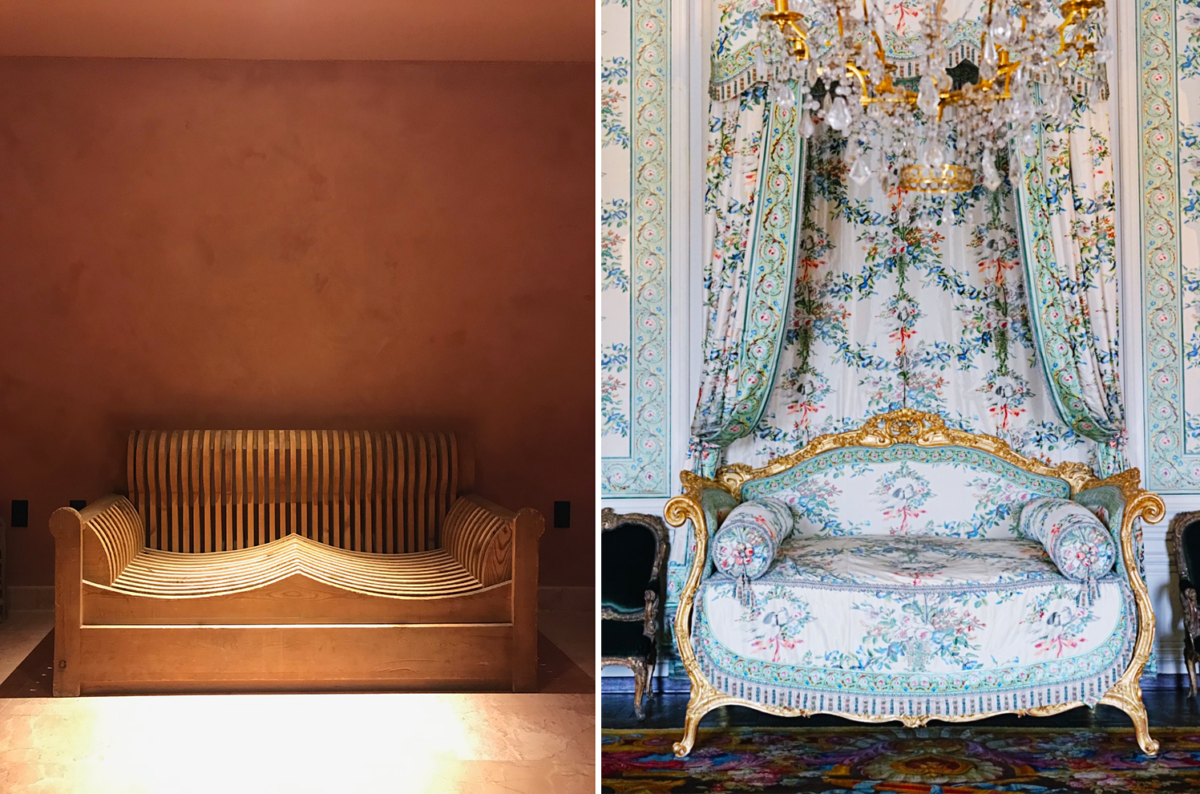What to do when you don’t see eye to eye on home design

If you are looking to make a change in your home, sign-ups just opened for my free live workshop! We only host this popular offering once a year, so make sure you check our session schedule and save your seat ASAP.
One kind of question I get asked a lot relates to the conflicts that come up between two individuals with different ideas about how to design a space. A few typical conundrums:
I love color (the more the better!) but my partner has a more minimalist style and is allergic to the idea of painting our walls. How do I convince him to let me use more color in our home?
or
The freedom aesthetic describes me perfectly — I love having lots of open space. But my partner is a clutterbug who leaves things on every surface, and my kids follow their lead. How can I get my family to be neater?
or
My wife has this painting she loves and I hate. It was given to her by a favorite aunt who passed away, so I know she won’t get rid of it. But looking at it every day drives me crazy!
While the situations vary, the problem is universal: sharing space with someone else is HARD. You have ideas about how you want your space to look and feel, and they don’t always line up with the other person’s (or people’s). And that tension about your space can spill over into the relationship, creating frustration and resentment.
The challenge with space is that it’s hard to ignore. Our homes surround us for much, if not most, of our waking lives. (And this has only become truer over the past couple of years.) I often talk about the benefits of adding small moments of joy to your home such as art or plants, because the frequency of being in contact with these items adds up over time. Unfortunately, the same is true of the small points of disagreement we have in our homes.
So how do you resolve these differences?
Some couples resort to compromise. They try to find a middle ground between their styles and stick within the safe zone. Each partner bends a little, and maybe leaves a piece of themselves out of the home for the sake of harmony.
Others take a “live and let live” approach. Rather than compromise, they bring both extremes into the mix and let them jostle together. This Onion piece offers a comical illustration of what can happen here:

But for most people, neither of these options is really satisfying. Compromise feels like everyone is settling, while coexistence feels like chaos. In both cases, neither partner really gets what they want.
The physical nature of the home can make it feel like a zero sum game. Either I get my way or you do — any middle ground feels like failure. And the perfectionism that tends to come out in matters of the home, fueled in part by our constant exposure to overstyled interiors on social media, intensifies our desire for full control of our surroundings, often without regard to the others in them. This is compounded by the popular distaste for seeing aspects of our interiors that reflect the real life lived there: messes, packaging, un-aesthetic toys, technology, and utilitarian objects that no one has yet figured out to make attractive. Rachel Cusk describes this tension in a 2016 essay for the New York Times called “Making House: Notes on Domesticity,” about her recent renovation:
What’s more, the very people — my family and friends — for whom this vision was realized threatened by their presence to defile it. I flinched when they sat on the new sofa, and I darted nervous glances at their shoes strolling imperviously over the unmarked floor; every scratch and scrape and stain felt as if it were being inflicted directly to my own flesh. I carped at my two adolescent daughters for leaving their possessions strewn over the furniture and berated them for the evidence they left of themselves in the kitchen. At the time I felt myself to be serving the reality of my domestic life with them — enhancing it, dignifying it — but now it almost seemed as if what I really wanted all along was to erase it.
This is the crux of the problem: to get our way when it comes to our homes often means subduing the will or erasing the existence of the people we love. Total victory might seem sweet, and very Pinterest-worthy — but there’s a very real cost. The house becomes more like an art piece, less like a home. Our people become obstacles to having the home we want instead of an integral part of it.
There is a solution, though, and it doesn’t involve carving the home up into man caves and she sheds or doing rock-paper-scissors for every decision. Nor does it mean swallowing our own desires and letting others “win.” Rather, it rests on recognizing that our space and our stuff are avatars for much deeper, more personal feelings about who we are and what we want out of life. To create a harmonious home, we need to get below the surface and start talking about how our individual desires relate to the shared idea of home that we’re creating together.
I feel so passionate about this topic that I devote an entire lesson to it in my Design a Home You Love course. In that lesson, I identify the most common conflicts in shared space and give tools for communicating with your partner about your home in non-judgmental, productive ways. (A gentle reminder that Design a Home You Love enrollment is opening back up soon. You can join the wait list here!)
In the rest of this post, I want share a few tips from that lesson that you can use to get on the same page with your partner so you can create a home that works for both of you, together.
Stop talking about stuff, start talking about your story
You’ve agreed you need a new sofa. One partner starts gathering options and shows them to the other expecting to be met with enthusiasm. Instead, they get this reaction: “Ugh. You like that?”
Ouch.
These kinds of disagreements are hard because we’ve been conditioned to see our style as a reflection of ourselves. When a partner wants to bring a beige La-Z-Boy or electric blue lounger into our traditional, Laura Ashley-inspired living room, it can feel like someone’s making us walk out of the house wearing mismatched clothes. Women in particular are often judged for the appearance of their homes, making the stakes in these tensions over style feel high. Yet such disagreements can also make us feel superficial. After all, how could someone care so much about a chair?
But that chair might be…
…tied to a memory that makes me feel safe. Maybe my grandfather had a chair like that, where he’d read me comics on Sunday mornings. It makes me feel calm in a world that feels out of control.
…a color that makes you feel agitated. Maybe when you look at it, you feel viscerally uneasy. You can’t explain it, but it’s more than just dislike.
…connected to how I want to see myself in the world. Maybe the chair feels unique and special to me, and makes me feel confident and creative.
…tied to a fear you have for the future. Maybe that chair costs a lot more than you’re used to spending on furniture. When you look at it, it makes you feel worried about our different approaches to money.
You can see where this is going. When we fight about style, we’re not fighting about colors and furniture, but our self-image, our heritage, our insecurities, our dreams, our values, and so much more. To resolve the tensions we have about style, ironically, we have to stop talking about the stuff, and start talking about our stories.
Next time you have this kind of disagreement (or better yet, before), ask your partner to tell you about the places in their life that have influenced what a home looks like to them. Listen without judgment and ask questions. Then ask them to do the same for you.
Often we unconsciously replicate or resist patterns in our childhood homes when we become adults. Maybe your parents were very private and hated when other people could see into your home, so in your mind it’s a given that all windows should have shades on them. Or maybe your partner grew up in a house where everything was fragile and you got yelled at if you broke things, so she avoids anything that looks too delicate because it makes her feel like she has to walk on eggshells. She may not even realize this is why she didn’t like the plates you showed her. She just knew they gave her a bad feeling.
Once you’ve surfaced these stories, it does a couple of things. First, gives you empathy for why your partner may not want the specific thing you’ve chosen. Second, it helps you understand another way you might achieve the same desire. (For example, choosing plants instead of painting the walls green, or getting a performance fabric that makes your partner less worried about spilling something on the sofa.) And lastly, talking about your experiences of home can be revelatory, giving you insight not just into your partner’s taste in furnishings, but their emotional history as well.
Think about designing a life, not decorating a home
If you’re getting into arguments about the details of your decor, it’s time to zoom out — way out. Disagreements about the tangible things in a home feel especially black and white because, due to the laws of physics, a chair can’t be two things at the same time. And once you purchase it, that’s what you’re going to be living with every day.
But behind the question of how to furnish your home is a much bigger one, best discussed in a relaxed state over a long meal and a glass of wine (if that’s your thing): how do you want to live? What kind of life are you building together, and how does your home help shape that life?
What I find whenever Albert and I have this conversation is that it immediately puts us into a more generative and imaginative mindset. Rather than squabbling over which chairs go where, we are reminded of why we were drawn to each other and inspired by each others’ dreams for what our life could be. We become less reactive and critical, and more open-minded. And what we create when we’re in this state of mind invariably leads to the best parts of our home.
Note: If you’re thinking about improving your home, or are running into tensions during a reno or redecoration project, my free guide 3 Questions to Ask Before Making Changes to Your Home can help you have these conversations more easily. Download it here, and use the questions as a prompt to get on the same page with your partner.
Focus on feels, not on looks
Whenever we start a home project, whether it’s a simple refresh for a room or a whole-house reno, the first question I always ask Albert is “How do you want to feel in this space?” Because he’s about as well-versed in my work as I am, we often talk in terms of the aesthetics of joy. (”I’m craving some freedom in here,” he might say. Or “It’s feeling flat in here. Can we get some energy in this room?”) But you don’t need to start with the aesthetics — any emotion words will do.
Try sitting in a room you want to change together and just sharing feelings you’d like to have when you’re in that space. It could be things like “light” or “cozy,” or more specific ideas like “as if I’m on vacation.” Keep talking until you have a shared understanding of your desired feeling that is clear and desirable to both of you.
When you look at things for this space, come back to these feelings. If you both agreed that you want to feel calm and airy in your bedroom, but one of you wants to paint the walls bright red, you now have a framework for discussion that’s about more than “I don’t like red.” It’s about a shared goal and how you achieve that together. (Same goes for random clutter or a heavy piece of furniture one of you is attached to. When you make the conversation about your shared desires, it’s easy to see when a design choice helps further the shared goal, or contradicts it. Even when the offending object belongs to you!)
When you’re in the throes of conflict about your space, and especially if you’re in the misery of a renovation or a move, it’s easy to get caught up in small disagreements. But decorating together doesn’t have to be a duel to the death of each of your personal styles. Rather than trying to win or to compromise, start from the belief that what you create together will be better than anything you could do on your own. Then go find that shared dream, and build it.
Reminder: My free live home workshop is coming soon! Learn how to create a home you love without moving, renovating, or spending money you don’t have. Save your seat right here.





Discussion (1 Comment)
I love this article so much–and it’s really helping me get to the bottom of why I can’t finish certain decisions about my home (and why I need to be more generous, rather than shut down a family member’s ideas for our home, even if they are vastly different than mine). This is such a needed space for an important topic that I’m not finding anywhere else. I always know I will learn something truly helpful when I pop in here. xx